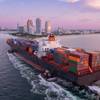Initiative Launched to Reduce Costs of Offshore Wind Parks
Achieving the Finnish windpower target by 2020 (6 TWh, approx. 2500 MW installed capacity) requires the implementation of several major offshore wind parks. The recently approved production tariff is not sufficient for implementation of offshore wind parks at the present cost level, and thus costs need to be reduced. Together with their customers, STX Finland, Meriaura and Hafmex have launched a ‘design-to-cost’ project, that seeks to significantly reduce the lifecycle costs of offshore wind parks.
Demand for electricity is expected to grow in the coming years, at same time that prices are expected to increase. After Italy, Finland is the second largest net importer of electricity within the EU, which places a burden on national economy and makes us dependent on external sources of electricity. Yet Finland has excellent wind conditions, and utilizing windpower in a larger scale would help our energybalance considerably. The current wind tariff already makes it economically viable to develop onshore wind parks. However, to get sufficient wind power, large offshore wind parks are also needed. The cost of these is still too high, so costs must be reduced considerably, preliminary estimations indicate up to 20-30% reductions.
STX Finland, Meriaura and Hafmex have recently signed a cooperation agreement by which the companies form a consortium to develop a cost-efficient overall solution for Finnish offshore wind parks. Through a ‘design-to-cost’ project the consortium seeks to reduce offshore wind park costs significantly. The project examines the whole life-cycle of offshore wind parks from design, engineering and measurements to building, operations and maintenance, including also potential wind turbine refurbishment and decomissioning. Energy companies and IPPs developing offshore wind parks and wind turbine manufacturers are also involved in the project. Early results indicate that offshore wind parks may be possible in the northern Baltic Sea more cost-effectively than previously thought.
"The implementation and lifecycle management of offshore wind parks in a cost-efficient manner is a very challenging task. The experiences gained in the North Sea show that success requires novel thinking and close cooperation throughout the whole process chain. This is something we want to drive here in the Baltic Sea, which has quite unique conditions. It has been great to see how various companies have brought their own expertise into the joint project. Solving this is important for all of us,” says Per Stenius, SVP Corporate Development of STX Finland Oy and head of wind power operations. He continues: “STX Finland’s shipyards and expertise in offshore and ice engineering combined with Meriaura’s special vessels and logistics know-how and Hafmex’s expertise in operations and maintenance create a solid foundation for the development work. In addition, energy companies and IPPs developing offshore wind parks have brought their perspectives into the project. By looking at the big picture and the overall process, we are able to bring new solutions to the problem."
“For quite some time, Meriaura has been involved in maritime environmental technology projects. Our multipurpose vessel Aura 1 has been collecting valuable experience from North Sea wind parks. Through this cooperation, we will be able to influence the development of implementation processes of offshore wind parks at an early stage and contribute our experience to the process in the best possible manner,” says Jussi Mälkiä, Chairman of the Board of Meriaura. Urpo Hauvonen, CEO of Hafmex Engineering Ltd. adds: “Every company engaged in this effort has a strong intent to develop the Finnish energy cluster in a more environmentally friendly direction and to leverage the engineering expertise found in Finland. Hafmex Engineering has been a pioneer in engineering, erection, and operations and maintenance of wind parks, and our experience in operating, for instance, the Via Wind Högsårö wind park brings a practical view to this work. Open dialogue and development of new ideas have helped us make quick progress."













